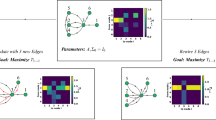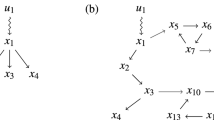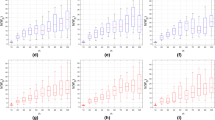Abstract
Networked systems display complex patterns of interactions between components. In physical networks, these interactions often occur along structural connections that link components in a hard-wired connection topology, supporting a variety of system-wide dynamical behaviours such as synchronization. Although descriptions of these behaviours are important, they are only a first step towards understanding and harnessing the relationship between network topology and system behaviour. Here, we use linear network control theory to derive accurate closed-form expressions that relate the connectivity of a subset of structural connections (those linking driver nodes to non-driver nodes) to the minimum energy required to control networked systems. To illustrate the utility of the mathematics, we apply this approach to high-resolution connectomes recently reconstructed from Drosophila, mouse, and human brains. We use these principles to suggest an advantage of the human brain in supporting diverse network dynamics with small energetic costs while remaining robust to perturbations, and to perform clinically accessible targeted manipulation of the brain’s control performance by removing single edges in the network. Generally, our results ground the expectation of a control system’s behaviour in its network architecture, and directly inspire new directions in network analysis and design via distributed control.
This is a preview of subscription content, access via your institution
Access options
Access Nature and 54 other Nature Portfolio journals
Get Nature+, our best-value online-access subscription
$29.99 / 30 days
cancel any time
Subscribe to this journal
Receive 12 print issues and online access
$209.00 per year
only $17.42 per issue
Buy this article
- Purchase on Springer Link
- Instant access to full article PDF
Prices may be subject to local taxes which are calculated during checkout






Similar content being viewed by others
References
Newman, M. E. J. Networks: An Introduction (Oxford Univ. Press, 2010).
Newman, M. E. J. The structure and function of complex networks. SIAM Rev. 45, 167–256 (2003).
Watts, D. J. & Strogatz, S. H. Collective dynamics of ‘small-world’ networks. Nature 393, 440–442 (1998).
Simon, H. The architecture of complexity. Proc. Am. Phil. Soc. 10, 467–482 (1962).
Bassett, D. S. & Sporns, O. Network neuroscience. Nat. Neurosci. 20, 353–364 (2017).
Bettencourt, L. M., Stephens, G. J., Ham, M. I. & Gross, G. W. Functional structure of cortical neuronal networks grown in vitro. Phys. Rev. E 75, 021915 (2007).
Bassett, D. S. & Bullmore, E. T. Small-world brain networks revisited. Neuroscientist https://doi.org/10.1177/1073858416667720 (2016).
Sporns, O. & Betzel, R. F. Modular brain networks. Annu. Rev. Psychol. 67, 613–640 (2016).
Barabasi, A. L., Gulbahce, N. & Loscalzo, J. Network medicine: a network-based approach to human disease. Nat. Rev. Genet. 12, 56–68 (2011).
Ching, S., Brown, E. N. & Kramer, M. A. Distributed control in a mean-field cortical network model: implications for seizure suppression. Phys. Rev. E 86, 021920 (2012).
Khambhati, A. N., Davis, K. A., Lucas, T. H., Litt, B. & Bassett, D. S. Virtual cortical resection reveals push-pull network control preceding seizure evolution. Neuron 91, 1170–1182 (2016).
Gonen, T. et al. Intra-operative multi-site stimulation: expanding methodology for cortical brain mapping of language functions. PLoS ONE 12, e0180740 (2017).
Mohanty, S. K. & Lakshminarayananan, V. Optical techniques in optogenetics. J. Mod. Opt. 62, 949–970 (2015).
Sprott, J. C. & Xiong, A. Classifying and quantifying basins of attraction. Chaos 25, 083101 (2015).
Cornelius, S. P., Kath, W. L. & Motter, A. E. Realistic control of network dynamics. Nat. Commun. 4, 1942 (2013).
Shine, J. M., Koyejo, O. & Poldrack, R. A. Temporal metastates are associated with differential patterns of time-resolved connectivity, network topology, and attention. Proc. Natl Acad. Sci. USA 113, 9888–9891 (2016).
Mantzaris, A. V. et al. Dynamic network centrality summarizes learning in the human brain. J. Complex Netw. 1, 83–92 (2013).
Bassett, D. S., Wymbs, N. F., Porter, M. A., Mucha, P. J. & Grafton, S. T. Cross-linked structure of network evolution. Chaos 24, 013112 (2014).
Kalman, R. E. Mathematical description of linear dynamical systems. J. SIAM Control Ser. A 1, 152–192 (1963).
Lin, C. T. Structural controllability. IEEE Trans. Autom. Control 19, 201–208 (1974).
Liu, Y. Y., Slotine, J. J. & Barabasi, A. L. Controllability of complex networks. Nature 473, 167–173 (2011).
Ruths, J. & Ruths, D. Control profiles of complex networks. Science 343, 1373–1376 (2014).
Gu, S. et al. Controllability of structural brain networks. Nat. Commun. 6, 8414 (2015).
Gu, S. et al. Optimal trajectories of brain state transitions. Neuroimage 148, 305–317 (2017).
Betzel, R. F., Gu, S., Medaglia, J. D., Pasqualetti, F. & Bassett, D. S. Optimally controlling the human connectome: the role of network topology. Sci. Rep. 6, 30770 (2016).
Muldoon, S. F. et al. Stimulation-based control of dynamic brain networks. PLoS Comput. Biol. 12, e1005076 (2016).
Oh, S. W. et al. A mesoscale connectome of the mouse brain. Nature 508, 207–214 (2014).
Rubinov, M., Ypma, R. J., Watson, C. & Bullmore, E. T. Wiring cost and topological participation of the mouse brain connectome. Proc. Natl Acad. Sci. USA 112, 10032–10037 (2015).
Shih, C. T. et al. Connectomics-based analysis of information flow in the Drosophila brain. Curr. Biol. 25, 1249–1258 (2015).
Kailath, T. Linear Systems (Prentice-Hall, 1980).
Fernandez, G. R. On how network architecture determines the dominant patterns of spontaneous neural activity. PLoS ONE 3, e2148 (2008).
Honey, C. J. et al. Predicting human resting-state functional connectivity from structural connectivity. Proc. Natl Acad. Sci. USA 106, 2035–2040 (2009).
Alstott, J., Breakspear, M., Hagmann, P., Cammoun, L. & Sporns, O. Modeling the impact of lesions in the human brain. PLoS Comput. Biol. 5, e1000408 (2009).
Aristidou, A. A., San, K.-Y. & Bennett, G. N. Modification of central metabolic pathway in Escherichia coli to reduce acetate accumulation by heterologous expression of the Bacillus subtilis acetolactate synthase gene. Biotechnol. Bioeng. 44, 944–951 (1994).
Sander, J. D. & Joung, J. K. CRISPR-Cas systems for editing, regulating and targeting genomes. Nat. Biotechnol. 32, 347–355 (2014).
Motter, A. E. Networkcontrology. Chaos 25, 097621 (2015).
Pasqualetti, F., Zampieri, S. & Bullo, F. Controllability metrics, limitations and algorithms for complex networks. IEEE Trans. Control Netw. Syst. 1, 40–52 (2014).
Lanteaume, L. et al. Emotion induction after direct intracerebral stimulations of human amygdala. Cereb. Cortex 17, 1307–1313 (2007).
Park, H., Niida, A., Miyano, S. & Imoto, S. Sparse overlapping group lasso for integrative multi-omics analysis. J. Comput. Biol. 22, 73–84 (2015).
Liu, Z., Lin, S., Deng, N., McGovern, D. P. & Piantadosi, S. Sparse inverse covariance estimation with L0 penalty for network construction with omics data. J. Comput. Biol. 23, 192–202 (2016).
Clauset, A., Moore, C. & Newman, M. E. Hierarchical structure and the prediction of missing links in networks. Nature 453, 98–101 (2008).
Zhu, B. & Xia, Y. An information-theoretic model for link prediction in complex networks. Sci. Rep. 5, 13707 (2015).
Chen, H. I. et al. Harnessing plasticity for the treatment of neurosurgical disorders: an overview. World Neurosurg. 82, 648–659 (2014).
Chrysikou, E. G. & Hamilton, R. H. Noninvasive brain stimulation in the treatment of aphasia: exploring interhemispheric relationships and their implications for neurorehabilitation. Restor. Neurol. Neurosci. 29, 375–394 (2011).
Bassett, D. S., Khambhati, A. N. & Grafton, S. T. Emerging frontiers of neuroengineering: a network science of brain connectivity. Annu. Rev. Biomed. Eng. 19, 327–352 (2017).
Johnson, M. D. et al. Neuromodulation for brain disorders: challenges and opportunities. IEEE Trans. Biomed. Eng. 60, 610–624 (2013).
Rubinov, M., Sporns, O., Thivierge, J. P. & Breakspear, M. Neurobiologically realistic determinants of self-organized criticality in networks of spiking neurons. PLoS Comput. Biol. 7, e1002038 (2011).
Shew, W. L. et al. Adaptation to sensory input tunes visual cortex to criticality. Nat. Phys. 11, 659–663 (2015).
Caeyenberghs, K., Verhelst, H., Clemente, A. & Wilson, P. H. Mapping the functional connectome in traumatic brain injury: what can graph metrics tell us? Neuroimage S1053–8119, 30694–30692 (2016).
van der Horn, H. J. et al. Altered wiring of the human structural connectome in adults with mild traumatic brain injury. J. Neurotrauma 34, 1035–1044 (2017).
Bollobas, B. Random Graphs (Academic, 1985).
Klimm, F., Bassett, D. S., Carlson, J. M. & Mucha, P. J. Resolving structural variability in network models and the brain. PLoS Comput. Biol. 10, e1003491 (2014).
Sizemore, A., Giusti, C. & Bassett, D. S. Classification of weighted networks through mesoscale homological features. J. Complex Netw. 5, 245–273 (2017).
Pfeil, T. et al. Six networks on a universal neuromorphic computing substrate. Front Neurosci. 7, 11 (2013).
Giusti, C., Papadopoulos, L., Owens, E. T., Daniels, K. E. & Bassett, D. S. Topological and geometric measurements of force-chain structure. Phys. Rev. E 94, 032909 (2016).
Acknowledgements
J.Z.K. acknowledges support from National Institutes of Health T32-EB020087, PD: F. W. Wehrli, and the National Science Foundation Graduate Research Fellowship No. DGE-1321851. J.M.S. and D.S.B. acknowledge support from the John D. and Catherine T. MacArthur Foundation, the Alfred P. Sloan Foundation, the US Army Research Laboratory and the US Army Research Office through contract numbers W911NF-10-2-0022 and W911NF-14-1-0679, the National Institute of Health (2-R01-DC-009209-11, 1R01HD086888-01, R01-MH107235, R01-MH107703, R01MH109520, 1R01NS099348 R21-M MH-106799, and T32-EB020087), the Office of Naval Research, and the National Science Foundation (BCS-1441502, CAREER PHY-1554488, BCS-1631550, and CNS-1626008). A.E.K. and J.M.V. acknowledge support from the US Army Research Laboratory contract number W911NF-10-2-0022. F.P. acknowledges support from the National Science Foundation (BCS-1430280 and BCS 1631112). The content is solely the responsibility of the authors and does not necessarily represent the official views of any of the funding agencies.
Author information
Authors and Affiliations
Contributions
J.Z.K., D.S.B. and F.P. wrote and revised the bulk of the manuscript. J.Z.K. developed the mathematical framework and analysed the data with feedback from F.P. and D.S.B. J.M.S. collected the human diffusion data, and A.E.K. processed the data to produce structural connectivity matrices with support from J.M.V.
Corresponding author
Ethics declarations
Competing interests
The authors declare no competing financial interests.
Supplementary information
Supplementary information
Supplementary information (PDF 2126 kb)
Rights and permissions
About this article
Cite this article
Kim, J., Soffer, J., Kahn, A. et al. Role of graph architecture in controlling dynamical networks with applications to neural systems. Nature Phys 14, 91–98 (2018). https://doi.org/10.1038/nphys4268
Received:
Accepted:
Published:
Issue Date:
DOI: https://doi.org/10.1038/nphys4268
This article is cited by
-
Controllability in attention deficit hyperactivity disorder brains
Cognitive Neurodynamics (2024)
-
Input node placement restricting the longest control chain in controllability of complex networks
Scientific Reports (2023)
-
Alprazolam modulates persistence energy during emotion processing in first-degree relatives of individuals with schizophrenia: a network control study
Molecular Psychiatry (2023)
-
Control theory illustrates the energy efficiency in the dynamic reconfiguration of functional connectivity
Communications Biology (2022)
-
Changes in dynamic transitions between integrated and segregated states underlie visual hallucinations in Parkinson’s disease
Communications Biology (2022)



